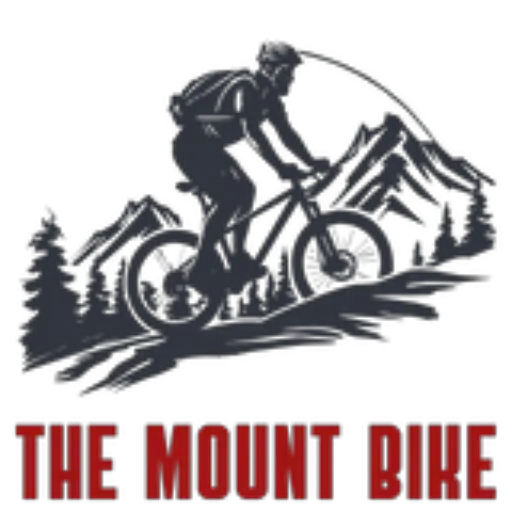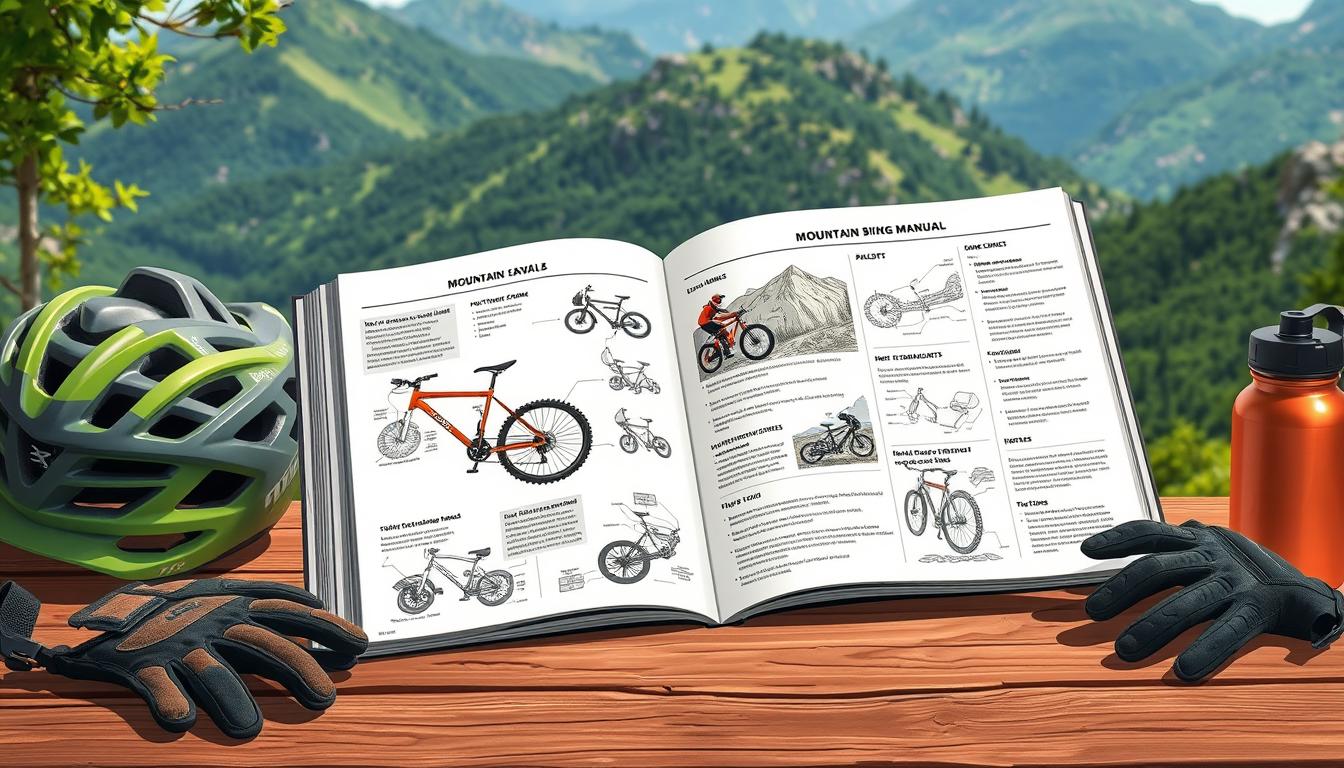Learning to manual on a mountain bike is key for any serious rider. It lets them lift the front wheel over obstacles and keep moving. Chris Gibbs says mastering this skill is vital for riding smoothly and stylishly over different terrains.
The Ninja Mountain Bike Skills source also highlights the manual’s role in lifting the front wheel over trail obstacles. This is a critical part of mastering the manual technique.
Mountain bike manual techniques are vital for bettering your biking skills. They help riders control their bikes in various terrains and situations. By learning these techniques, riders can enhance their biking experience and improve their skills.
This article will guide you through mountain bike manual techniques. You’ll learn about their benefits, the basic physics, and step-by-step instructions. It’s designed to help you improve your skills and master mountain biking.
Getting better at mountain biking takes practice and dedication. But with the right techniques and guidance, riders can quickly get better at manual techniques. By focusing on mastering the manual, riders can improve their control and balance.
This allows them to handle more challenging trails and obstacles with confidence.
Key Takeaways
- Mastering the mountain bike manual technique is essential for negotiating terrain with flow and style.
- Mountain bike manual techniques are crucial for improving mountain biking skills and controlling the bike in various terrain and situations.
- Learning how to manual mtb can enhance the overall mountain biking experience and take skills to the next level.
- Improving mountain biking skills requires practice and dedication, but with the right techniques and guidance, riders can quickly progress.
- Focusing on how to manual mtb and mastering the manual technique can improve control and balance, allowing riders to tackle more challenging trails and obstacles with confidence.
- Mountain biking skills, including the manual technique, are essential for any serious mountain biker.
Understanding the Mountain Bike Manual Technique
Learning to do a wheelie is key in mountain biking. It begins with mastering the manual technique. Chris Gibbs explains that this method lifts the front wheel over obstacles using the hips, not the arms. It’s vital for off-road cycling techniques and useful in many situations, like at a pump track or to avoid deep ruts.
To get the hang of the manual technique, you need to grasp the basic physics. This means moving your weight back and using your hips to lift the front wheel. Bike handling tips like keeping the back brake covered can stop the bike from flipping out. Also, using flat pedals and the right shoes can boost your confidence and help you learn manuals better.
- Lowering saddle heights slightly to make it easier to learn manuals
- Using a combination of disc/V brakes with good modulation, true wheels, and properly set levers for two-finger braking
- Practicing on a slight downhill slope to find the right speed
By following these tips and practicing often, riders can get better at mastering the wheelie. This will also improve their off-road cycling techniques.
Essential Safety Gear for Manual Practice
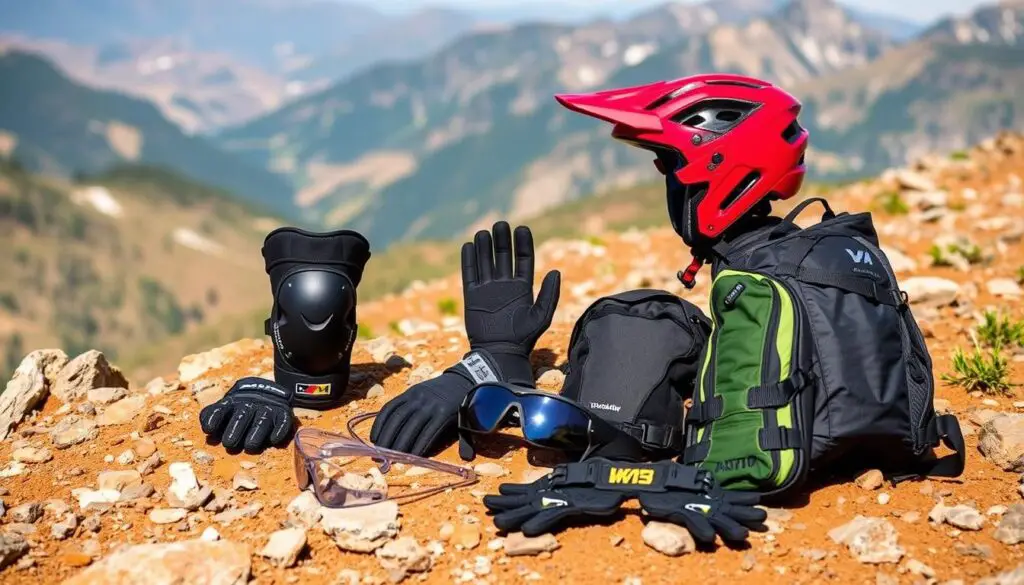
Mastering mountain bike control means safety first. The right gear is key to avoid injuries from falls or losing control. You’ll need a helmet, knee pads, and elbow pads, as many sources suggest.
Getting better at balancing on a bike takes time and patience. But with the right safety gear, you can lower the risk of getting hurt. A helmet is essential to protect your head. Knee and elbow pads help safeguard your joints from injury if you fall.
Here are some key safety gear items to consider:
- Helmet: A sturdy, well-fitting helmet that meets safety standards
- Knee pads: Pads that provide protection for your knees and shin area
- Elbow pads: Pads that protect your elbows and forearms
Wearing the right safety gear lets you focus on improving balance on a bike and mastering manual techniques. Always put safety first when practicing mountain biking skills.
With the right safety gear and practice, you’ll soon master mountain bike control. You’ll enjoy the excitement of manual riding.
| Safety Gear Item | Description |
|---|---|
| Helmet | Protects your head from impact |
| Knee Pads | Protects your knees and shin area |
| Elbow Pads | Protects your elbows and forearms |
Preparing Your Mountain Bike for Manual Training
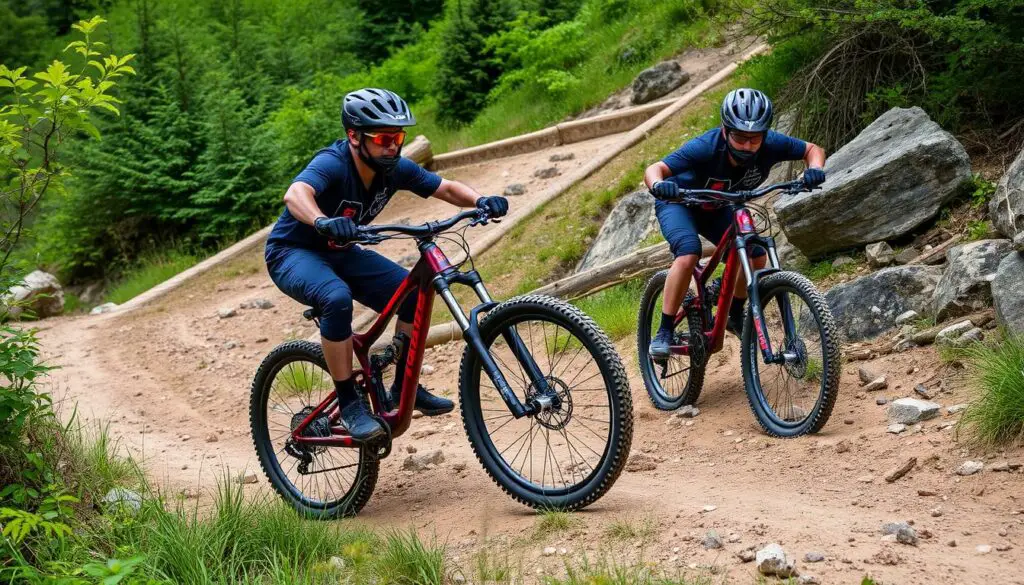
To master mountain bike manual techniques, you need to prepare your bike. This means setting up your bike right, checking the tire pressure, and adjusting the brakes. A well-prepared bike helps you learn bike handling tips for tough trails.
Preparing your mountain bike for manual training is key, as the Ninja Mountain Bike Skills source says. You should set up your bike to fit your riding style and the terrain. Adjusting the saddle height and handlebar position can greatly improve your manual skills.
Finding the right tire pressure is crucial. Lower pressure gives more grip but raises the risk of punctures. Higher pressure boosts speed but reduces grip. Experimenting with different pressures helps you handle various terrains better.
Optimal Bike Setup
Having the right bike setup is vital for mastering mountain bike manual techniques. Adjust the brake levers, gear shifters, and saddle to match your riding style. Fine-tuning your bike improves your handling and prepares you for tough trails.
Tire Pressure Considerations
Tire pressure greatly affects mountain bike manual techniques. Adjusting it can enhance grip, speed, and handling. It’s important to try different pressures to find the best for your riding style and terrain.
Brake Adjustment Tips
Proper brake adjustment is essential for mastering mountain bike manual techniques. Adjusting the brake levers and pads improves stopping power and handling. Always follow the manufacturer’s brake adjustment instructions for safety on trails.
Perfect Body Positioning for MTB Manuals
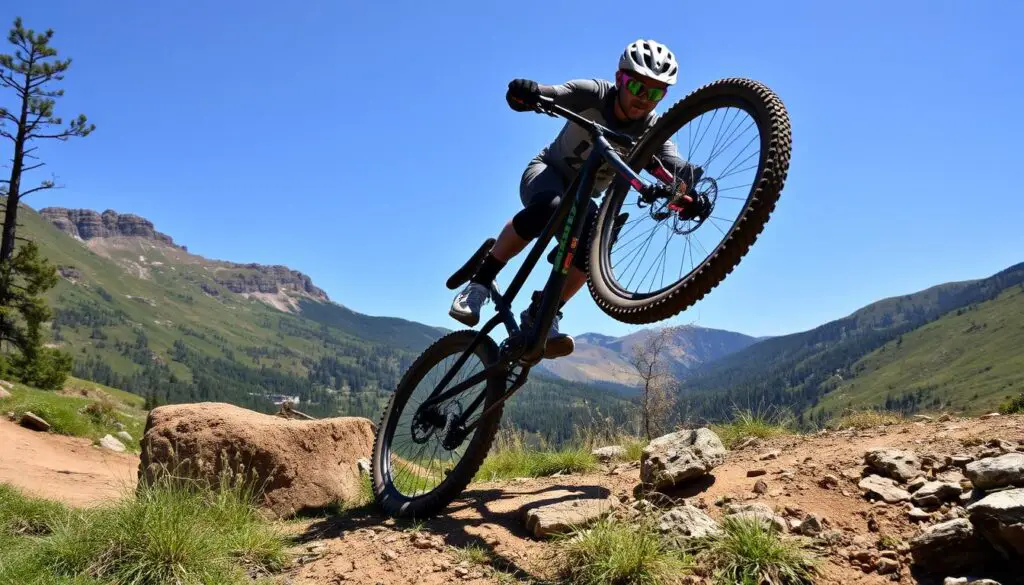
Learning to manual on a mountain bike is all about body positioning. Chris Gibbs says it’s key to master the manual. You need to sit right over the bike, with your weight balanced evenly.
Shifting your weight back is important. You can do this by pressing your weight into your heels and extending your legs. This makes your body form an L-shape. Also, keep your arms straight and use your body weight to stay in the manual position.
Eye focus is crucial in mountain biking, including manuals.
Looking at the front wheel when starting a manual makes it hard to look away. You focus on balance as soon as the wheel leaves the ground.
To do better, keep your eyes on the horizon or something ahead. This helps you manage your weight and control better.
- Ride at a jogging pace or slightly faster for enough momentum
- Keep a finger on your rear brake for quick control
- Practice with experienced instructors at clinics to boost your skills
Mastering the manual takes time and effort. Start slow and get used to the bike’s balance. With patience and practice, you’ll get the hang of how to manual mtb and enhance your mountain biking skills.
How to Manual MTB: Step-by-Step Guide
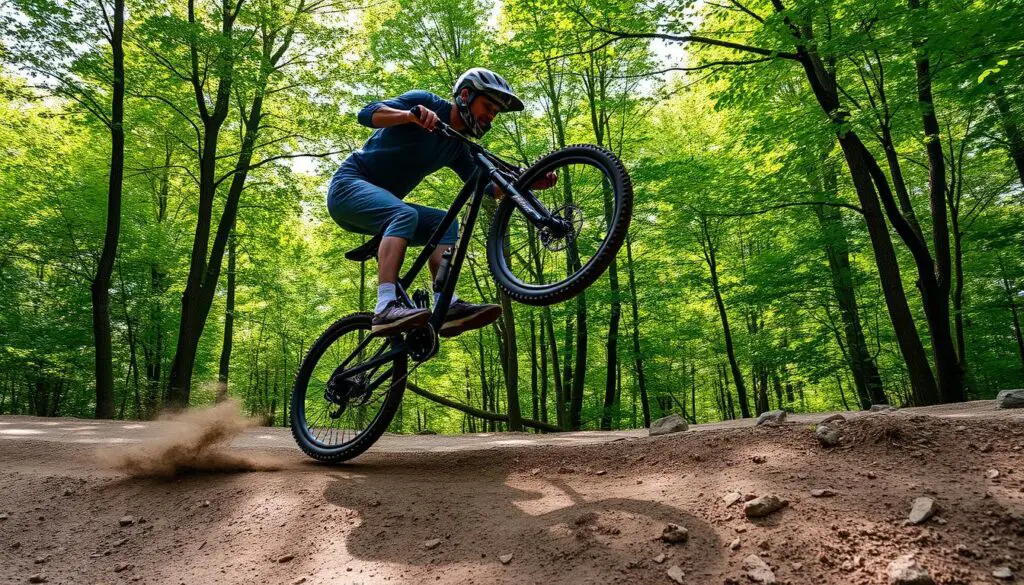
To master the manual technique in mountain biking, it’s key to understand the importance of mastering the wheelie and using off-road cycling techniques. The manual technique is about lifting the front wheel over obstacles. This is done by using the hips, not the arms, to keep moving.
The Ninja Mountain Bike Skills source says finding the balance point is key for good manuals. The Ninja Manual Trainer tool helps riders find and trust this balance point. Start practicing manuals at a jogging pace or slightly faster to keep control.
Finding Your Balance Point
Start small to feel the balance point, use your weight instead of arms, and focus on shifting your weight back. This helps lift the front wheel without pulling up with your arms. Always keep a finger over the rear brake while doing a manual for safety.
Initial Movement Sequence
The first step is to shift your weight back and lift the front wheel. This takes practice and patience. By using off-road cycling techniques and mastering the wheelie, riders can get better at manuals.
| Practice Tips | Benefits |
|---|---|
| Start small to feel the balance point | Improves balance and control |
| Use weight instead of arms | Reduces arm fatigue and improves technique |
| Focus on shifting weight back | Helps to lift the front wheel and maintain momentum |
Maintaining the Manual Position
Keeping the manual position right takes a lot of practice and focus on mastering the wheelie and off-road cycling techniques. By following these tips and practicing often, riders can get better at manual mountain biking.
Common Manual Mistakes and Solutions
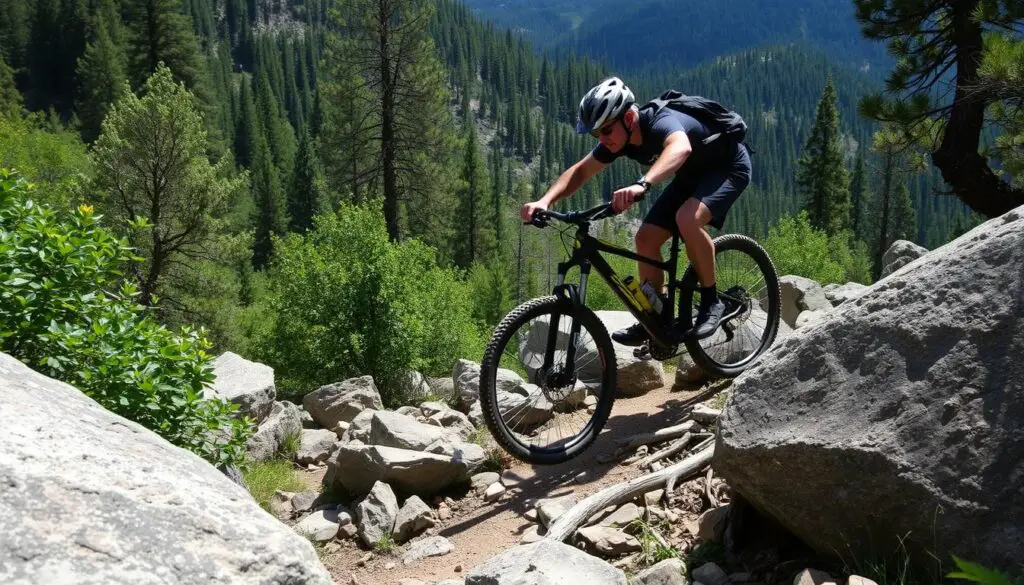
When you’re learning mountain bike control, knowing common mistakes is key. One big error is pulling up on the handlebars instead of moving your weight back. This can mess up your balance and make it hard to stay steady. Many people make this mistake because they don’t get the physics behind manual techniques.
Mastering mountain bike control means learning to shift your weight well. This skill comes from focusing on your center of gravity and adjusting as needed. Some common mistakes include:
- Incorrect body positioning, which can affect your overall balance and stability
- Insufficient practice, leading to a lack of muscle memory and coordination
- Failure to adjust to different terrain and trail conditions, which can catch you off guard and disrupt your balance
Knowing these mistakes and working to fix them can help you improve your mountain bike skills. Stay focused, keep practicing, and always be aware of your balance and position on the bike.
As you keep practicing and getting better, you’ll feel more in control of your bike. You’ll be ready to take on tougher trails with confidence.
Progressing Your Manual Skills
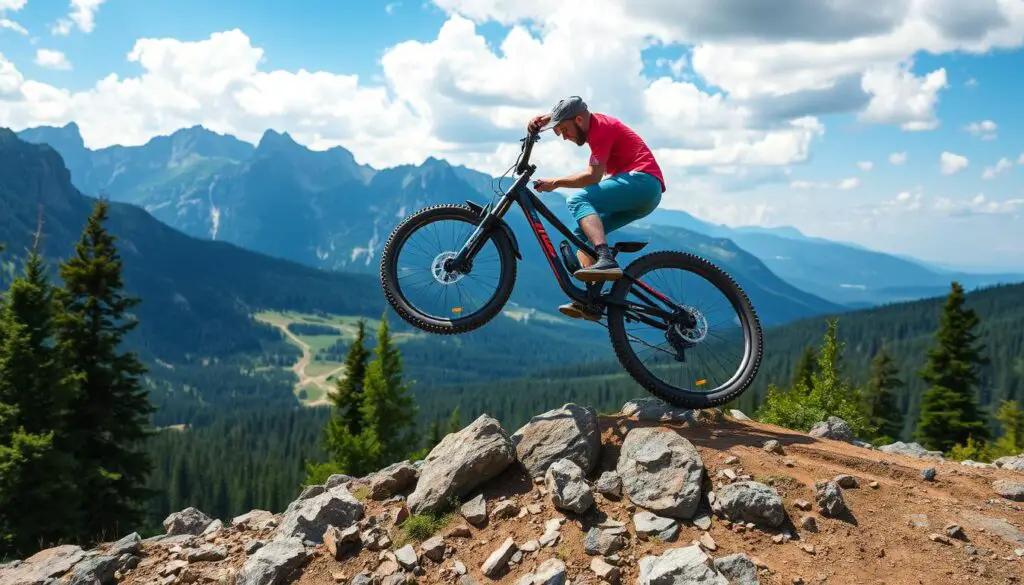
Once you’ve got the basics down, it’s time to get better. You’ll want to ride farther, change speeds, and handle tough terrain. To do this, work on your core, balance, and smooth pedaling.
The Ninja Mountain Bike Skills guide says to focus on distance and speed changes. Start on flat ground, then try hills and obstacles. Keep your balance, push with your legs, and keep a steady pace.
- Start with short distances and gradually increase the length as you build confidence and control.
- Vary your speed to adapt to different terrain and obstacles, from walking pace to jogging pace.
- Practice on different terrain, such as rocky or mountainous trails, to improve your overall mountain biking skills.
By following these tips and practicing often, you’ll get better at how to manual mtb. Stay focused, balanced, and pedal smoothly. Soon, you’ll be a pro at manuals.
Advanced Manual Techniques for Trail Riding
As riders get better at mountain biking, they want to improve their skills. They aim to ride on harder trails. Advanced manual techniques are key for this, helping riders move smoothly over tough trails. Chris Gibbs says linking manuals with other skills is vital for advanced riders.
Important skills include cornering with speed and confidence, energy management, and building confidence on technical trails. Mastering these skills boosts performance and makes riding on rough terrain easier. For instance, front wheel lifts can turn into wheelies and manuals. Bunny hops help clear obstacles without losing speed.
Linking Manuals with Other Skills
Advanced riders need to link manuals with cornering, climbing, and descending. This means practicing nose pivots in tight turns, wheelies to avoid dips, and manuals to lift the front end off drops. Combining these skills makes navigating complex trails easier and more confident.
Technical Trail Applications
Applying advanced manual techniques to real trails is crucial. This includes handling steep descents, technical climbs, and tight turns. By practicing, riders can improve and conquer tough trails with confidence. Key techniques include:
- Looking far ahead and focusing on the exit while turning
- Using manuals to lift the front end off drops
- Practicing wheelies to avoid dips
Mastering these techniques elevates mountain biking skills. Riders can confidently tackle challenging trails. They use mountain bike manual techniques and off-road cycling techniques to enhance their performance.
| Skill | Description |
|---|---|
| Manuals | Boosting the front end off fast drops and rolling over obstacles |
| Wheelies | Keeping the front wheel out of dips and placing the front wheel where needed |
| Nose Pivots | Navigating tight turns where bike length space is limited |
Building Strength and Endurance for Better Manuals
To get better at manuals, you need to work on your strength and endurance. Mastering the wheelie is all about being physically fit and knowing how to handle your bike. The Ninja Mountain Bike Skills source says that strength and endurance are key to improving your manual skills.
Focus on your core, legs, and heart health. Doing exercises that work these areas will help you do wheelies better. Also, learning bike handling tips like how to position your body and balance your bike will make you ride smoother.
Here are some tips to boost your strength and endurance for manuals:
- Do strength training like squats and lunges to strengthen your legs
- Practice bike handling tips like balancing and moving your bike in different places
- Begin with short rides and slowly make them longer as you get more endurance
By following these tips and working on your strength and endurance, you can get better at manuals. Always ride safely and don’t push yourself too hard. If you need help, ask experienced riders or instructors for advice.
Mental Preparation and Confidence Building
Mastering mountain biking needs both physical skill and mental prep. It’s key to balance well and control your bike for a good manual. Studies show that getting mentally ready and boosting confidence are vital to beat fear and up your manual game.
To build confidence and get mentally ready, try visualization techniques, progress tracking, and overcoming fear. These methods can help you control your bike better and enjoy riding more.
For instance, a study showed that those who used visualization and tracked their progress did better in racing. Also, facing fears and gaining confidence lets you ride tougher trails and try new skills like manuals and jumps.
By focusing on mental prep and confidence, you can improve your mountain biking. Whether you’re new or experienced, better balance and control are key for a successful manual and reaching your riding goals.
| Strategy | Benefits |
|---|---|
| Visualization Techniques | Improved focus and concentration |
| Progress Tracking | Increased motivation and confidence |
| Overcoming Fear | Enhanced mental toughness and resilience |
Troubleshooting Your Manual Technique
Learning how to manual mtb means spotting and fixing mistakes. Mountain biking skills need practice, patience, and never giving up. Start by working on balance and how your weight is spread.
Here are some tips to boost your manual technique:
- Keep your crank arms parallel to the ground
- Shift your weight to keep the front wheel off the ground
- Use your entire body, including arms and legs, to lift the front wheel
- Distribute your weight equally and center your mass around the bike’s rear axle
Don’t lock your knees or keep your legs straight during manuals. Use your hips and weight to steer the bike. With time and effort, you’ll get the hang of it and enhance your mountain biking skills.
For more tips on fixing your manual technique, check out the Ninja Mountain Bike Skills source. Or, join a MTB Clinic with a Ninja instructor.
| Troubleshooting Tips | Description |
|---|---|
| Start small | Begin with short manuals and gradually increase the distance |
| Focus on balance | Practice balancing on the bike, both stationary and in motion |
| Use weight instead of arms | Shift your weight to control the bike, rather than relying on arm strength |
Conclusion: Mastering the Mountain Bike Manual
Learning to do mountain bike manuals takes time and effort, as Chris Gibbs says. This skill is key for riding off-road, helping you handle tough terrain with ease. To get better, you need to be patient, keep practicing, and never give up.
Choosing the right bike is important when learning mountain bike manual techniques. Air forks are light and adjustable, great for beginners. Coil forks offer a smooth ride, perfect for those who like to ride hard. Adjusting the bike’s settings can also make a big difference.
Adding mountain bike manual techniques to your off-road skills will make you a better rider. Always keep your goals in mind and keep practicing. Soon, you’ll master the manual and improve your mountain biking skills.

I am Ryan Ford, a mountain biking enthusiast who loves to explore the outdoors. I also like to go on adventures with friends and anything else that involves being outside. I love my bike because it gets me out of the house and gives me an opportunity to enjoy nature.
